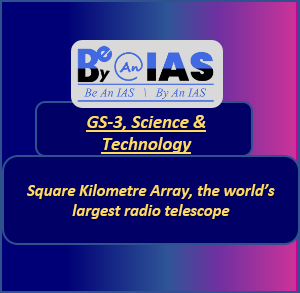CURRENT AFFAIRS
Get the most updated and recent current affair content on Padhaikaro.com
Square Kilometre Array, the world’s largest radio telescope
- Be N By IAS, Delhi
- 06, Feb 2021

For : GS-3: Science & Technology
CONTEXT:
- On Thursday, the Square Kilometre Array Observatory (SKAO) Council held its maiden meeting and approved the establishment of the world’s largest radio telescope.
WHAT ARE RADIO TELESCOPES?
- Unlike optical telescopes, radio telescopes can detect invisible gas and, therefore, they can reveal areas of space that may be obscured by cosmic dust.
- First radio signals: Significantly, since the first radio signals were detected by physicist Karl Jansky in the 1930s, astronomers have used radio telescopes to detect radio waves emitted by different objects in the universe and explore it.
- Since World War-2: According to NASA, the field of radio astronomy evolved after World War II and became one of the most important tools for making astronomical observations since.
- The Arecibo telescope: In Puerto Rico, which was the second-largest single-dish radio telescope in the world, collapsed in December 2020.
- The telescope was built in 1963 and because of its powerful radar, scientists employed it to observe planets, asteroids and the ionosphere, making several discoveries including
- Finding prebiotic molecules in distant galaxies,
- The first exoplanets, and
- The first-millisecond pulsar.

SIGNIFICANCE ABOUT THE SKA TELESCOPE:
- largest in the world: The telescope, proposed to be the largest radio telescope in the world.
- Location: It will be located in Africa and Australia in Southern Hemisphere, whose operation, maintenance and construction will be overseen by SKAO.
- Timeline and fund: The completion is expected to take nearly a decade at a cost of over £1.8 billion.
- Application:
- beginning of the universe,
- how and when the first stars were born,
- life-cycle of a galaxy,
- exploring the possibility of detecting technologically-active civilisations elsewhere in our galaxy
- Understanding where gravitational waves come from
- Methodology: By measuring neutral hydrogen over cosmic time, accurately timing the signals from pulsars in the Milky Way, and detecting millions of galaxies out to high redshifts.
SQUARE KILOMETRE ARRAY OBSERVATORY (SKAO) COUNCIL:
- SKAO is a new intergovernmental organisation.
- It is dedicated to radio astronomy.
- HQ: UK.
- Members: At the moment, organisations from ten countries are a part of the SKAO. These include Australia, Canada, China, India, Italy, New Zealand, South Africa, Sweden, the Netherlands and the UK.

Source: The Indian Express
Q. Proposed Square Kilometre Array would be the world’s largest radio telescope. It can be used in understanding
- Beginning of the universe
- How and when the first stars were born
- Exploring the possibility of detecting technologically-active civilisations elsewhere in our galaxy
- Where gravitational waves come from
Which of the above statements is/are correct?
- a) 1 and 2 only
- b) 2 and 3 only
- c) 1, 2 and 4 only
- d) 1, 2, 3 and 4
ANS: D